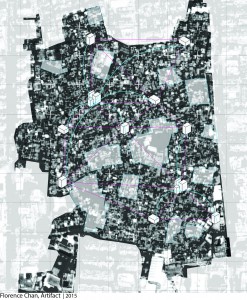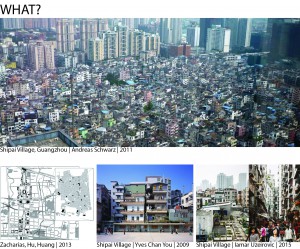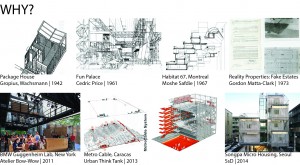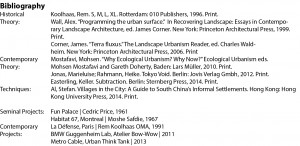Urban Resource Lab: Collective Sharing
|
Urban Resource Lab: Collective Sharing Future cities will concern less about building permanent objects, but more about providing voids that adapt to constant spatial changes. The flexibility of staging for uncertainty is key to the future of collective sharing urbanism.
Urban Resource Lab This thesis proposes to develop a prototype for an urban resource lab that allows people to participate in sharing facilities and exchanging resources. The site for the design project is an mixed-use urban area in mega city. It will be focus on developing a prototype in the scale of a neighborhood block. Overtime, the prototype can be reconfigure and relocate to adapt to the neighborhood. The scope is to have a network of urban resource labs that could interact with each other and the larger city as a whole. The labs will be inserted into the urban fabric as public infrastructure occupying the urban voids. Urban Village in Guangzhou In 2013, there were 245 millions of migrant workers in China and over 100 million of them live in the urban villages. The city of Guangzhou has over 1.2 million migrants living in the urban villages. Shipai Village is one of the largest urban village located in Guangzhou, China. It has a population about 270,000 people living in 40 hectares of land. And over 50,000 people are migrants. It is with this high density and scale of an urban area that can put the urban resource lab to test serving a neighborhood block and connect to the larger city. The prototype will respond to the change of migrant population in ways that can be reconfigure and relocate according to the amenities and services needed of migrant community in neighborhood.
From Prefab to Adaptable & Participatory Starting in the mid 20th Century, the desire to industrialized building systems have led many architects to the design of prefab architecture. Since the package house design by Groupius and Wachsmann, the concept of building low cost and easy to assembly panelized architecture have advanced towards a more customizable and reconfigurable architecture evident in the Habitat 67 by Moshe Safdie and later the Nakagin Capsule Tower by Kisho Kurokawa during metabolism. During the same period, Cedric Price had published his design called Fun Palace that is always under construction and never complete. It is mainly a structural grid that holds many small mobile parts for various programs like a transformable machine. Here from basic customizable prefab units seen in Habitat 67, Price has used this time-based urban intervention to suggests the flexible and adaptable future of architecture based that invite people to participate in the process. Cities are by nature in a constant flux of people and resources. The migration of rural workers to urban areas remains one of the most significant phenomenon in urbanization. During the past decade, more architects are developing urban think thanks globally to tackle problems such as slums, urban village, and social housing. The ever more influence in architecture is the design that can promote participation and sharing. As evident in many of the projects in Caracas by the U-TT, that by inserting little piece of public infrastructure can help the neighborhood to connect and improve. Network of Inter-relationships This thesis proposes that the future of urban citizens will be active in resource sharing, rather than being singular and absolute. The project seeks to design a prototype for an urban resource lab that encourage people to share and exchange. The prototype will be modularize and become adaptable to the urban voids serving the neighborhood in a network.
Design Methodology The project will focus on using models to develop prototypes accompany by a series of analysis drawings, mappings, and diagrams to illustrate the working of resource sharing. Step 01: Research Examine existing sharing condition in the city. Identify available resources and amenities to share. Understand the relationship between each resources and speculate the pattern of use by people in a series of analysis drawings. (Due Week 3/ Review 1.0) Step 02: Massing & Program. Identify voids in the city and select testing neighborhood block. Finalize target user, program, area, material and modes of operation. Develop 1:500 massing and schematic models to test on site model. (Due Week 10/ Review 2.0) Step 03: Network System. Detail design of prototype in models and drawings in 1:100. Rationalize the design to fit the site condition. Develop overall network plan in city. Visualize the process of construction, reconfiguration, and relocation. (Due Week 16, Review 03) Step 04: Refine Design. Revision of plans, drawings, diagrams, and models. Finalize all drawings and models. (Due Week 19, Final Review)
|




